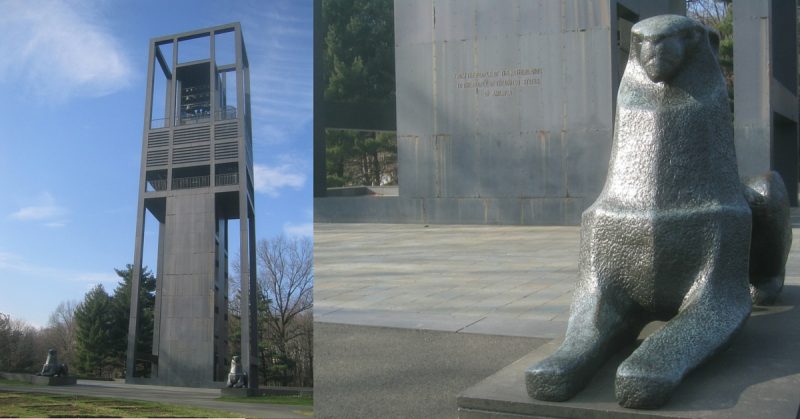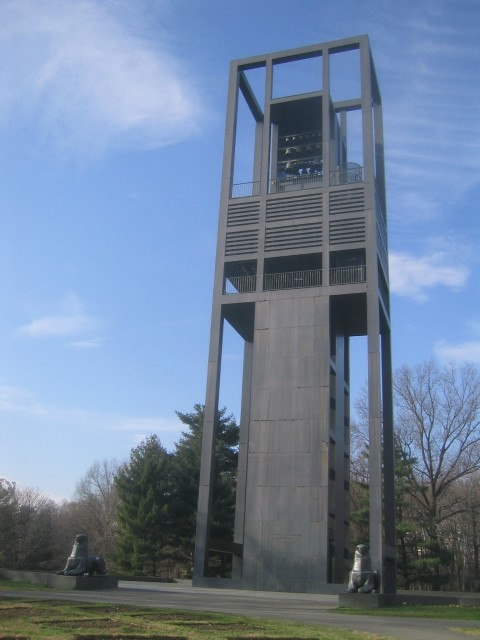Almost 60 years ago the people of the Netherlands gave the United States with a gift – the bronze bells of the Netherlands Carillon, which have been ringing from an elevated point between the Iwo Jima Memorial and Arlington National Cemetery ever since.
The United States received this gift as a token of the Dutch appreciation for liberating them from the Germans during World War II, coupled with postwar aid. It is a tower that stands at 127 feet just west of the George Washington Memorial Parkway. Its 50 bells are maintained in tandem with the annual visit of the Dutch Carillonneurs, but the tower is undoubtedly showing its age. Furthermore, Dutch diplomats are concerned that the story behind the gift is slowly being lost with the passing of the World War II generation.
The National Park Service, the Netherlands Embassy, and the newly created Trust for the George Washington Memorial Parkway are working together to gather funds for restoration, reservation, and programming of the carillon. These efforts will kick off this week.
Royal Netherlands Ambassador Henne Schuwer on Tuesday said, “It’s very important for a number of people who know about the history and friendship between the U.S. and the Netherlands. Part of what we are trying to do is reestablish that understanding . . . The idea [of the bells] is whether you are big or small, you chime in together to make music.”
Queen Juliana of the Netherlands made a visit to the United States in 1952, during which she gave President Harry S. Truman a small silver bell to represent what was to come. A temporary tower with 49 bells cast in the Netherlands was installed in the District’s Meridian Hill Park two years later. In 1960 the tower was relocated to its current spot. In 1970 and 1995 renovations were completed, and a 50th bell was added to the mix. The bells vary in size and weight from 42 pounds to 6-1/2 tons.
On Wednesday the staff from the Embassy placed a wreath at the carillon from the Netherland’s annual Remembrance Day. It is a day to honor those who died in defense of the nation. Thursday is the country’s Liberation Day and the Dutch Carillonneur Boudewijn Zwart will perform at the carillon for 300 invited guests.
The parkway’s superintendent, Alexcy Romero, put in a request for $2.7 million in National Park Service funds to deal with “safety” needs at the carillon. The money was for removing rust, repainting the structure, and repairing the floors, railings, and exterior metal cladding. However, competition for funds within the Park Service is a real problem. Romero hopes he is awarded the funds in order to reopen the lower half of the structure – it has been closed to guided tours for visitors for more than five years at this point. It is only normal that people want to be able to see a remarkable view of the monuments on the Mall; not to mention the beautiful Dutch tulips that bloom at the start of each spring on site. Romero said, “It’s almost like a historic home, because once you start opening up the walls, you don’t know what you will get. The fear is not knowing how strong the steel is.”
On a related note, the nonprofit parkway trust embassy will set out to raise $1.7 million to make upgrades to the musical equipment, which includes replacing the clappers in the bells. The partners are hoping to have educational programs along with a webcam installed to record the head Carillonneur Edward M. Nassor and guest musicians at the keyboard. The main goal is to establish an endowment that enables the carillon to be kept in good condition.
Duncan Blair is an Alexandria lawyer who pointed out that the parks are free of admission costs, but still need to be funded. He added, “This is a magnificent symbol — a stunning memorial. We want people to come here and enjoy it as a cultural resource.”
High in the tower, just below the narrow winding staircase to the Carillonneur’s station, these massive bells can be seen through wire screens. According to the Netherland’s embassy officials, each bell is meant to uniquely carry an emblem that represents groups within the Dutch society. One bell has an inscription that was translated by an embassy employee. It says, “The song resonates with the gratitude of the Dutch people.”

